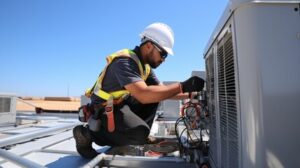HVAC professionals need to be able to use a variety of tools and test equipment. They also need to understand safety precautions and follow best practices.

Understanding basic HVAC components helps homeowners take a proactive role in their own thermal comfort and energy efficiency. Taking action to correct issues like uneven temperature distribution and noisy fans can save energy, improve comfort, and prevent costly repairs.
The heating part of your HVAC system works in conjunction with your air conditioner to provide thermal comfort all year round. Unlike the cooling system, which uses a refrigerant that circulates through compressors and coils, the heating system relies on furnaces and blowers to heat and cool homes.
Furnaces use natural gas, oil or electricity to heat your home’s air, and a blower fan circulates that warm air throughout your house via ductwork. Many modern systems are also capable of controlling humidity, which is a crucial component for preventing mold and mildew in your ductwork. The evaporator coil in a modern system collects the water vapor that condenses, thereby helping your home stay less humid and improving indoor air quality.
A heat pump, another common type of system, is capable of both heating and cooling. It transfers heat from the air to your home’s ductwork and back again, reducing energy costs by up to 30%. When evaluating a heat pump, make sure to look for its SEER rating, which tells you how efficiently it works.
Other parts of a modern system include a thermostat, which regulates the temperature in your home or building and is usually digital or smart. Some units have an air return, which improves ventilation by pulling stale air from ductwork and pushing fresh air into it. You can also add a zoning system to control the temperature in different areas of your home.
Cooling
The cooling component of HVAC keeps homes and commercial buildings comfortable during hot weather. Its heating component warms the air during winter, while its ventilation component circulates and replenishes fresh air. Its air conditioning component cools the air and dehumidifies it for maximum comfort. HVAC systems are vital to indoor environments, and they’re employed in homes, schools, hospitals, malls, airports, office buildings, and many other settings.
The evaporator coil in your air conditioner absorbs heat energy from the warm air that blows through it with the system’s blower. The evaporator coil converts the refrigerant fluid in a frigid, vaporous state into a cool, liquid form that absorbs the heat from the warm air and blows it back through your supply ducts as chilled air.
As the refrigerant continues its journey through the system, it passes through a compressor that pressurizes it and concentrates its heat-absorbing properties. Then it dumps the concentrated heat into a set of condenser coils, which cool the liquid to a more ambient temperature and blown through your supply ducts to your living spaces.
Some HVAC systems like ductless mini-splits do not use a central AC unit. These units have their own fans that exchange air directly with your living space without the help of ducts, and they can be more affordable than a traditional central HVAC system. However, you should get your ducts cleaned every two to five years to prevent moisture and other problems from building up inside them.
Ventilation
The V in HVAC stands for ventilation, and a key function of an HVAC system is to provide constant air movement throughout a building. This helps to keep indoor temperatures stable, removes odors and fumes from kitchens and bathrooms, reduces humidity and recirculates fresh outdoor air.
Ventilation is typically accomplished through a network of ducts that are attached to an air conditioning unit and heat pump. Ducts are designed to deliver warm or cool air to multiple parts of a home using a low-pressure system that avoids a strong flow of air known as draught, which can cause discomfort for occupants. The ducts are lined with insulation to prevent energy loss.
Air is drawn into the ventilation system through intake vents, then filtered to remove particles, then heated or cooled and dehumidified before it is distributed. A ventilation system can also be controlled with sensors that detect when the building is occupied and adjusts the amount of outside air supplied.
Highly efficient HVAC systems can help to cut energy consumption, which in turn cuts greenhouse gas (GHG) emissions and saves money for homeowners. They do this by saving on energy used to operate fan and compressor units, and by reducing the total energy use of the building.
Filters
Filters play an important role in keeping your HVAC system and the air inside your home clean. They help to filter out small particles like dust, pollen, and pet dander, which can improve your indoor air quality. These filters also prevent these particles from recirculated throughout your home and into the sensitive parts of your HVAC system, where they can cause damage and decrease efficiency. When choosing an air filter, pay attention to its MERV rating. The higher the MERV rating, the more efficient the filter is.
Mechanical filters use synthetic fibers to trap small particles as air passes through them. They’re usually inexpensive and easily available at stores such as Home Depot and Lowes. These disposable filters typically have a MERV rating of 1 to 6, and are good for basic air filtration. They’re not suitable for allergy or asthma sufferers, however.
Pleated filters use polyester or cotton to increase the surface area of the filter, which helps to capture more airborne pollutants. These filters are usually available with a MERV rating of 5 to 16. They’re the most common choice for homeowners, and they’re good for families that have mild allergies or pets.
Electrostatic filters use self-charging fibers to attract and trap airborne pollutants. These filters are often used in conjunction with HEPA filters, which have a MERV rating of 17 to 20. They can capture extremely tiny particles such as bacteria and viruses. They’re available in washable versions that can be washed and reused, which makes them a more eco-friendly option than other types of filters.
Ductwork
Ductwork may seem like a minor part of an HVAC system, but its design and quality impact how well your HVAC performs. Even new homes can have poorly designed or insulated ductwork, which limits airflow and compromises comfort and indoor air quality. Recognizing signs of duct problems allows homeowners to take action and avoid costly repairs later.
A key component in a duct system is the air distribution box, called a plenum. The supply plenum delivers conditioned air to rooms with air vents, while the return plenum directs used air back to the air handler. The air handler then filters and recycles the used air.
Insufficient or overly restrictive ducting can create a number of problems, including inefficient heating and cooling, dust buildup, poor indoor air quality, allergens, and mold. Signs of poor ductwork include a sudden increase in energy costs, unexplained coughing and sneezing, and musty or foul odors.
In addition to duct trunks and pipes, a complete duct system includes multiple fittings, such as reducers, tees, turning vanes, and vent caps. Other ductwork components include insulation, which helps maximize efficient airflow by slowing down the movement of heated or cooled air. The duct system also has drain pans to catch moisture, which can cause rust or mold if left unchecked. Keeping these components properly sealed and insulated prevents water from entering the duct system, which can cause a host of other problems.
Heat Pump
Unlike boilers and electric baseboard heaters that create heat by burning fossil fuels, the heat pump transfers thermal energy between your home and outdoor air. This system can efficiently cool your home, dehumidify the air and provide heating without burning any fuel, making it a smarter, cleaner alternative to traditional systems.
It works by using a system of coils to absorb heat from the surrounding air, ground or water. A reversing valve then switches the flow of refrigerant from one direction to another. In cooling mode, the coils release heat outdoors, while in heating mode, they absorb heat from outside air or the ground and then redistribute it indoors. The only thing a heat pump does not do is generate its own heat.
In addition, heat pumps require significantly less energy to operate than gas furnaces because they do not burn fossil fuels in order to produce heat. They also use clean electricity which means they do not emit pollutants into the environment, like nitrogen oxides and carbon dioxide.
The best part is that heat pumps can be used in most climates, and some models are even ENERGY STAR rated. They can be installed with existing ducting or are available as a ductless mini-split unit if you live in an older or new construction space without ductwork. These versatile systems will reduce your energy bills by delivering hot and cold air where you want it in your home, year-round.


